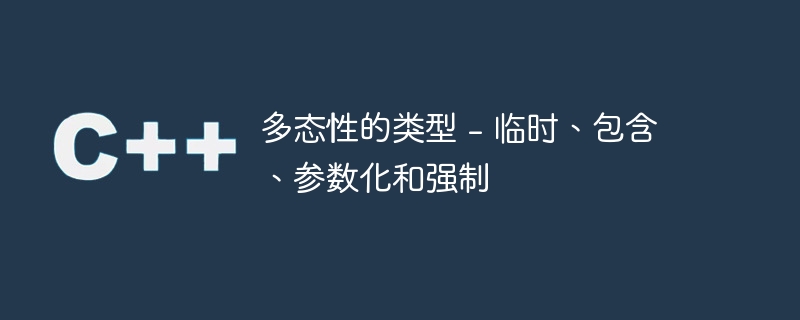多态性的类型 - 临时、包含、参数化和强制
- WBOYWBOYWBOYWBOYWBOYWBOYWBOYWBOYWBOYWBOYWBOYWBOYWB转载
- 2023-09-23 10:21:041461浏览

在这里我们将看到不同类型的多态性。类型为 -
- Ad-Hoc
- 包含
- 参数化
- 强制
Ad-Hoc 多态性称为重载。这允许具有相同名称的函数针对不同的类型以不同的方式起作用。函数和运算符都可以重载。有些语言不支持运算符重载,但函数重载很常见。
示例
#include<iostream>
using namespace std;
int add(int a, int b) {
return a + b;
}
string add(string a, string b) {
return a + b; //concatenate
}
int main() {
cout << "Addition of numbers: " << add(2, 7) << endl;
cout << "Addition of Strings: " << add("hello", "World") << endl;
}输出
Addition of numbers: 9 Addition of Strings: helloWorld
包含多态性称为子类型化。这允许使用基类指针和引用来指向派生类。这就是运行时多态性。在执行之前我们不知道实际对象的类型。我们需要 C++ 中的虚函数来实现这种包含多态性。
示例
#include<iostream>
using namespace std;
class Base {
public:
virtual void print() {
cout << "This is base class." << endl;
}
};
class Derived : public Base {
public:
void print() {
cout << "This is derived class." << endl;
}
};
int main() {
Base *ob1;
Base base_obj;
Derived derived_obj;
ob1 = &base_obj; //object of base class
ob1->print();
ob1 = &derived_obj; //same pointer to point derived object
ob1->print();
}输出
This is base class. This is derived class.
强制多态称为强制转换。当对象或基元被转换为某种其他类型时,就会发生这种类型的多态性。铸造有两种类型。隐式转换是使用编译器本身完成的,显式转换是使用 const_cast、dynamic_cast 等完成的。
示例
#include<iostream>
using namespace std;
class Integer {
int val;
public:
Integer(int x) : val(x) {
}
operator int() const {
return val;
}
};
void display(int x) {
cout << "Value is: " << x << endl;
}
int main() {
Integer x = 50;
display(100);
display(x);
}输出
Value is: 100 Value is: 50
参数多态性称为早期绑定。这种类型的多态性允许对不同类型使用相同的代码。我们可以通过使用模板来获取它。
示例
#include<iostream>
using namespace std;
template <class T>
T maximum(T a, T b) {
if(a > b) {
return a;
} else {
return b;
}
}
int main() {
cout << "Max of (156, 78): " << maximum(156, 78) << endl;
cout << "Max of (A, X): " << maximum('A', 'X') << endl;
}输出
Max of (156, 78): 156 Max of (A, X): X
以上是多态性的类型 - 临时、包含、参数化和强制的详细内容。更多信息请关注PHP中文网其他相关文章!
声明:
本文转载于:tutorialspoint.com。如有侵权,请联系admin@php.cn删除

